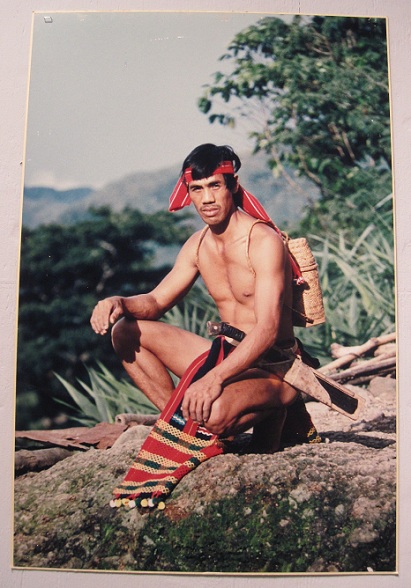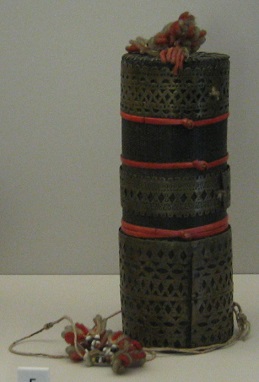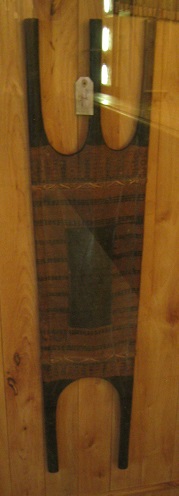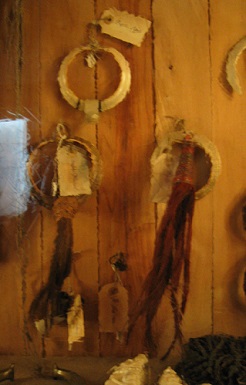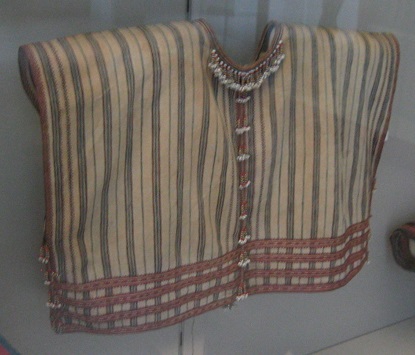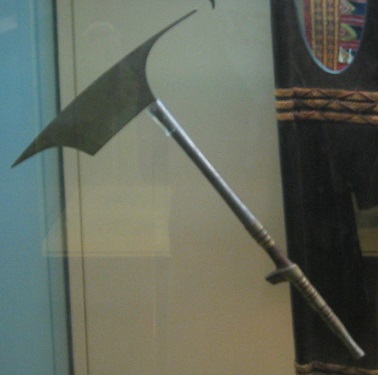Subject: pangat chief
Culture: Kalinga Igorot
Setting: central Luzon 19th-early 20thc
Evolution:
Context (Event Photos, Primary Sources, Secondary Sources, Field Notes)
* Benitez/Barbier 2000 p138
"In the past, the institution of headhunting was one of the most prominent aspects of Cordillera highland culture and the most impelling motive for inter-village warfare. The practice was a prerequisite for ceremonies performed during planting, harvesting, funerals, marriages and house construction. Successful head-takers gained prestige and reached certain levels of social rank."
* Power and gold 1985 p242
"The social class system consists of four levels: the kapus, or poor people; the baknang, or wealthy class; the kadangyan, rich aristocrats who also head kinship groups; and the pangat, a small group of male political leaders drawn from the kadangyan. This last class is rather unusual in Luzon, ... and represents considerable political centralization and separation from simple kin-based leadership." [references omitted]
* Power and gold 1985 p243
"Kalinga art focuses on ceremonial gatherings, oratory, fancy dress, and ornamentation for the wealthy class. This is no surprise for a prosperous society based on irrigated rice cultivation. The pangat (the class of noblemen with political duties) solidified their positions through fine oratorical performances, by maintaining numerous peace pacts, and -- at one time -- through homicide. Barton reports that at the time of his research some pangat were unashamedly citing acquired rather than inherited wealth as part of the rationale for their high position, but headhunting was already on the wane." [references omitted]
Hat
* Howard 2000 p42
"Kalinga males ... wear 'o-kong' hats made of more elaborate woven materials, adorned with beautifully colored beads and, in some cases, two mother-of-pearl double circles on either side of the tiny hat, which is held on the head with a string of beads."
Jewelry
* Power and gold 1985 p336
"Bronze dinumug in the basic open oval shape. This type of ornament is quite common in many Northern Luzon cultures, and comes in a variety of somewhat modified forms all built around the fundamental open oval. Such ornaments were used as earrings, singly or in pairs, or as pendants, on chains. Several different types of dinumug were sometimes grouped together on necklaces. Similar to the open oval ling-ling-o and related stylistically to the pinangpanga."
Spear
* Howard 2000 p177
"tobi -- spear (Kalinga)"
Shield
* Benitez/Barbier 2000 p138
"A warrior went into battle with a steel battle axe, between one and three steel or wooden spears, and a wooden shield that he used both for parrying and attacking. The Kalinga, Tinguian and Bontoc carved similar types of shields from a single piece of light wood carevd with three prongs above and two below the central body. They frequently cut a slight vertical protrusion along the midrib, sometimes adding a boss. Bejuco twine was lashed tightly around the prongs to prevent the shield from splitting.
"The Kalinga and Tinguian frequently embellished their shields with geometric patterns directly linked to marks traditionally tattooed on men's forearms. ... Like those painted on lime containers and woven on textiles, these motives closely relate to headhunting. George Ellis notes that these shield types are stylised representations of the human figure: the two lower prongs are the legs, the protective board is the body and the three upper prongs, the head and upraised arms. Moreover, Ellis adds, the Kalinga examples are slimmer and more gracefully shaped than the wide bodies and stout prongs produced by the Bontoc and Tinguian, a distinction he parallels with the groups' physical attributes."
* Jenks 1905 p124
"[T]he Kalinga shield [is] a slim, gracefully formed shield, differing from the typical Bontoc weapon chiefly in its more graceful outline. It is of a uniform black color and has the bejuco lacings the same as the others."
* Demetrio 1991 v2 p594
"Kalinga shields are called kalasag and are made from either the sablang tree (a tree with beautiful red blossoms which bloom in March), the dapdap tree, or the polay tree. These woods are light, yet they do not usually crack when dry. Sablang was preferred for shields actually used in tribal wars in the past, as it is most resistant to splitting. The other woods are used to make shields for training young warriors. Two types of shields are: a long one with three rather high prongs tapering down to two prongs; and the other not tapering, with shorter prongs and smaller as a whole. The first type undecorated is usually blackened, or rather, smoked to harden the wood. The other is painted, usually orange, and decorated with intricate black designs. Both types are stitched with rattan just before the beginning of the prongs in order to strengthen the prongs. A swelling or protrusion at the center protects the fingers that grip this shield." [reference omitted]
Ax
* Demetrio 1991 v2 p585
"The Kalinga have two types of headaxes. The first is called sinawit, a narrow type of headaxe generally considered by the Kalinga as a headaxe [SIC]. The other type is called gaman. This headaxe is more squat in size and is used as a working tool for clearing swidden and for other tasks." [reference omitted]
* Howard 2000 p177
"pinagas -- headhunting ax [var. of Bontoc kaman] (Kalinga)"
* Demetrio 1991 v2 p585
"The typical Kalinga head axe is slender, with curved blade and a longer handle spur, as opposed to the heavier, straightblade Bontoc axe." [reference omitted]
Bracelet
* Howard 2000 p56
"In Kalinga tradition, the hair of a head hunting victim may be dyed red and attached to boar tusks, forming a kind of bracelet caled the 'tuckar' which is passed down through generations and worn by the men during rituals and other important ceremonies."
Costume
* Howard 2000 p44
"Although both men and women have traditionally clothed only the bottom half of their bodies, this dress is full of rich symbolic and graphic detail. A short loin cloth, the Kalinga male's 'fa-ar,' is as fully covered with geometric designs as his female Kalinga counterpart's 'ai-in' skirt."
* Harper/Peplow 1991 p251
"Formerly fierce headhunters, Kalingas are a proud people with a taste for decoration and ornaments; the male Kalinga is known as the 'peacock of the mountain provinces.'
